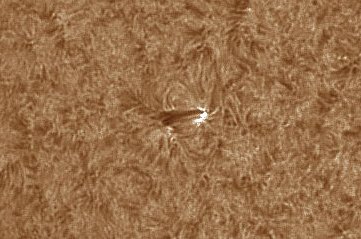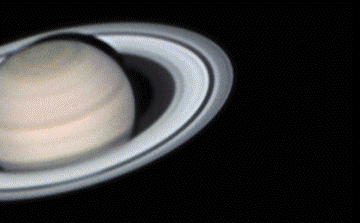| TWO SPACESHIPS, ONE FLYBY: Space shuttle Discovery docked to the International Space Station on Sunday, August 30th, carrying a load of high-tech equipment to outfit the station's science labs. Joined together, the two massive spaceships outshine every star in the night sky. Check the Simple Satellite Tracker for flybys of your hometown. NEW SUNSPOT: A new sunspot is emerging about 15o north of the sun's equator: map. Pete Lawrence sends this picture from his backyard observatory in Selsey, UK: 
"It is small, but a welcome sight, especially after the current long run of no surface activity," he says. Indeed, if this active region consolidates into a true dark-cored sunspot, it will break a string of nearly 52 spotless days, one of the longest quiet spells of the current solar minimum. Readers with solar telescopes are encouraged to monitor developments. VANISHING RINGS: On Sept. 4, 2009, Saturn will turn its rings edge-on to Earth, and for the first time in 14 years they will seem to disappear. "To mark the occasion I've made an animation combining six years of Saturn observations," says New York amateur astronomer Alan Friedman. "It shows the changing plane of the ring system as viewed from my Buffalo backyard from 2004 to 2009." 
"The final frame is constructed from observations I made earlier this year," he explains. "it shows how the planet will appear on Sept. 4th." Unfortunately, the actual ring plane crossing on Sept. 4th will be practically impossible to observe. "On that day, Saturn will be very close to the sun--only 11o away--and the glare will hide the big event. In the fall of 2009, Saturn will emerge from the glare of the sun in the early morning sky and provide Earth-bound astronomers with our first glimpse of its blue north pole in 14 years."
August 2009 Aurora Gallery
[previous Augusts: 2008, 2007, 2006, 2005, 2004, 2003, 2002, 2001]
Explore the Sunspot Cycle | 
